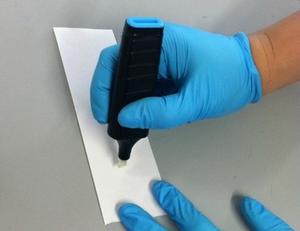ForensicsA crime-fighting “magic” marker pen picks up hidden fingerprints
A crime-fighting “magic” marker pen that can identify the hidden properties of receipts containing fingerprint deposits within a matter of seconds will be demonstrated at the Knowledge Transfer Network’s (KTN) Applications of Forensic Science Research and Development Technology Showcase 2014 event today (8 October) in London.

Pen reveals formerly undetectable fingerprints on paper // Source: www2.le.ac.uk
A crime-fighting “magic” marker pen that can identify the hidden properties of receipts containing fingerprint deposits within a matter of seconds is one of the innovative gadgets developed by scientists at the University of Leicester that will be demonstrated at the Knowledge Transfer Network’s (KTN) Applications of Forensic Science Research and Development Technology Showcase 2014 event today (8 October) in London.
A University of Leicester release reports that the pen, which has been developed by Dr. John Bond OBE from the University of Leicester’s Department of Criminology, provides forensic experts, police, and criminal investigators with an easy-to-use method of determining whether a receipt, such as those from petrol stations, supermarkets and ATMs, is printed on thermal paper.
The pen works by initiating a chemical reaction on the paper that changes its color if it is thermal.
Once identified as thermal paper, another gadget Bond will be showing at the event comes into play - a specially designed light source for identifying fingerprints on thermal paper that can be used to catch criminals by the paperwork they have been touching.
Dr. Bond explained: “The ‘magic’ marker pen works by impregnating the paper with a small amount of a chemical that I discovered will react with the dye, changing its color. This chemical is mixed with others in the marker to provide a viscous liquid, ideally suited for application with a marker-type pen.
“The idea is that a small corner of the receipt could be marked with the pen and if it changes color it is thermal paper. Touching a small corner of the receipt will minimize the potential destruction of any fingerprints on the paper, helping to retain forensic evidence. The pen-like shape of the device will be handy to have in the pocket for technicians to apply as and when it is needed.”
The conventional method of treating non-thermal paper turns thermal paper black, obliterating any fingerprints in the process, which cannot be undone. The pen allows for paper to be quickly identified, which will be useful in criminal investigations when extracting fingerprints from a variety of paper documents is necessary.
Both technologies will be demonstrated at the KTN event, supported by the Home Office Center for Applied Science and Technology (CAST) and Innovate UK, which strives to take new ideas and concepts to market.
Dr. Julie Pratt from the University of Leicester’s Enterprise and Business Development Office said: “Dr. Bond has the knack of identifying problems that have impeded the efficient identification and visualization of latent fingerprints and then develops simple, low cost, rapid and robust solutions, ideal for implementation by forensic technicians. These solutions are ready to go and Leicester is looking for a licensing partner to manufacture and sell the products.”
Dr. Bond added: “It is very prestigious for the University of Leicester to be represented at events like this that showcase innovation and, in this instance, forensic innovation.
“Enabling the police service to make use of advances in technology is very important in helping to solve and reduce crime and I’m proud that our work is recognized in this way by the Forensic Science Special Interest Group at Innovate UK.”
The Applications of Forensic Science R&D Technology Showcase 2014 event is taking place today (8 October) in London and is organized by the Forensic Science Special Interest Group (FoSci SIG), of the KTN.
The FoSci SIG is a community of everyone involved in Forensic Science, including end users, suppliers of products and services, academics and other researchers, and policy makers.
Given the interdisciplinary nature and societal importance of forensic science, the SIG was set up with the primary purpose of enabling closer networking and better communication between all forensic science stakeholders for improved R&D.
